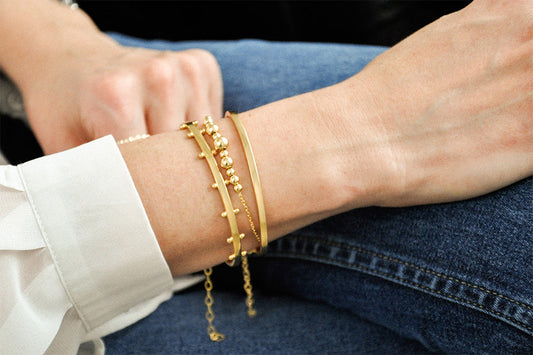
What Do 999, 916, 750, 585, and 417 Mean on Gold Jewelry? A Complete Karat Guide
When shopping for gold jewelry, you may notice small numbers stamped on each piece — like 750, 585, 999, or even 417. But what do these numbers actually mean? These tiny marks aren’t random; they represent the purity of the gold used in that item, expressed in what's called the millesimal fineness system. Understanding what numbers like 999, 916, 750, 585, and 417 mean can help you make smarter decisions when choosing between different gold qualities. In this guide, we’ll walk you through each of these gold purity levels and explain how they impact price, durability, and everyday wear.
Table of Content
What Do Gold Stamps Like 999, 916, 750, 585, and 417 Mean?
Gold jewelry is often marked with small numbers — known as hallmarks — that indicate the purity of the gold used. These numbers are measured using the millesimal fineness system, which expresses the amount of pure gold in parts per thousand. In other words, a piece stamped with “750” contains 750 parts pure gold out of 1000, or 75% purity.
Here’s how the system works at a glance:
999 = 99.9% pure gold → also known as 24 karat
916 = 91.6% pure gold → also known as 22 karat
750 = 75.0% pure gold → also known as 18 karat
585 = 58.5% pure gold → also known as 14 karat
417 = 41.7% pure gold → also known as 10 karat
These stamps not only reflect the gold content but also affect the value, color, durability, and wearability of the jewelry. Higher numbers generally mean purer gold — but that doesn’t always mean better, especially for everyday use. In the following sections, we’ll break down what each of these gold stamps means and which one may be the best fit for your lifestyle.

What Is 999 Gold? The Purest Form of Gold (24K)
Gold marked with 999 represents the highest possible level of purity — 99.9% pure gold, also referred to as 24 karat gold. This form of gold is essentially free from other metals and alloys, giving it a rich, deep yellow hue that many people associate with traditional gold.
Because of its extreme purity, 999 gold is soft and malleable, which makes it less ideal for intricate or high-stress jewelry like rings or chains that are worn daily. For this reason, 24K gold is most commonly found in investment-grade bars and coins, or in cultural jewelry used for special occasions (especially in regions like India, China, and the Middle East).
While it offers the prestige of purity, 999 gold is more prone to scratching, bending, and losing shape under pressure. So if you're looking for a piece to wear every day, lower-karat gold options may be more practical. However, for heirloom pieces or ceremonial use, 24K gold remains unmatched in beauty and value.
What Does 916 Mean in Jewelry? Understanding 22 Karat Gold
Jewelry stamped with 916 indicates that the piece contains 91.6% pure gold, which corresponds to 22 karat gold. This alloy is created by mixing pure gold with a small percentage of other metals like copper or silver to improve durability, while still preserving most of gold’s natural richness and color.
22K gold strikes a balance between purity and practicality. It retains the luxurious deep yellow tone of high-karat gold but is slightly more durable than 24K, making it suitable for jewelry like necklaces, bangles, and earrings, especially those meant for occasional or cultural wear.
That said, 22K gold is still softer than 18K or 14K, so it’s not always ideal for rings, chains, or bracelets that face daily wear and tear. It’s most popular in regions where the cultural or symbolic value of gold purity is high, such as India, the Middle East, and parts of Southeast Asia.
If you’re looking for gold that feels premium and pure — but with slightly improved strength compared to 24K — 916 gold offers a beautiful middle ground.
What Is 750 in Jewelry? The Balance of 18 Karat Gold
Jewelry marked with 750 contains 75% pure gold, which makes it 18 karat gold. This is one of the most popular gold purities in fine jewelry — and for good reason. It offers an excellent balance between luxury, durability, and everyday practicality.
Thanks to its alloy composition (25% other metals like silver, copper, or palladium), 18K gold is significantly stronger than 22K or 24K, making it much more suitable for daily wear items like engagement rings, wedding bands, or bracelets. At the same time, its gold content is still high enough to maintain a rich, warm yellow tone that looks and feels premium.
18K gold is especially popular in Europe and the U.S., and often seen in both minimalist and high-end designer jewelry. If you’re looking for gold jewelry that offers both elegance and long-term durability, 750-marked pieces are a smart and sophisticated choice.
What Does 585 Mean in Jewelry? Why 14 Karat Is a Global Favorite
Jewelry stamped with 585 contains 58.5% pure gold, making it 14 karat gold. This is one of the most commonly used gold purities around the world — especially in the United States, Europe, and Canada — thanks to its ideal mix of affordability, durability, and beauty.
With nearly 42% alloy metals in its composition, 14K gold is stronger and more resistant to scratching or bending than higher karat options. That makes it perfect for everyday jewelry such as rings, bracelets, earrings, and necklaces that need to stand up to regular wear.
Visually, 14K gold still maintains a warm yellow tone, though it is slightly less rich in color than 18K or 22K. However, many people find this softer golden hue more subtle and versatile, especially for casual or modern designs.
If you want jewelry that looks luxurious but can also keep up with your daily routine, 585-marked pieces offer excellent value and long-term reliability.

What Is 417 Gold? A Practical Option for Durability (10K)
A 417 stamp on jewelry indicates that the piece is made of 41.7% pure gold, which corresponds to 10 karat gold. This is the minimum karat value that can still legally be marketed as “real gold” in many countries, including the United States.
Because it contains a higher percentage of alloy metals (58.3%), 10K gold is the most durable among all standard gold types. It’s highly resistant to scratching, denting, and bending, making it a popular choice for affordable and practical jewelry — especially for items that are exposed to wear and tear, like class rings, watches, or work-safe accessories.
However, the trade-off is that 10K gold has a paler yellow color compared to higher karat options, and it may be slightly more likely to cause skin irritation in people with metal sensitivities due to the increased alloy content.
Still, for budget-conscious shoppers or those seeking maximum durability, 417 gold provides a solid, long-lasting option without sacrificing the prestige of wearing real gold.

Bonus: What Does 925 Mean — and Why It’s Not Gold
If you've ever come across jewelry stamped with 925, you might wonder if it’s another form of gold — but it’s not. The 925 hallmark actually refers to sterling silver, not gold. It means the piece is made of 92.5% pure silver, with the remaining 7.5% usually consisting of other metals (like copper) to increase strength and durability.
While silver and gold can sometimes be confused due to gold plating or mixed-metal designs, it’s important to note that 925 is never used to indicate gold purity. If you see a piece marked 925 that appears gold in color, it’s likely gold plated over sterling silver, also known as gold vermeil — not solid gold.
Understanding this distinction helps prevent confusion and ensures you're making informed purchases. When looking for genuine gold jewelry, always look for stamps like 999, 916, 750, 585, or 417 — and remember that 925 means silver, not gold.






